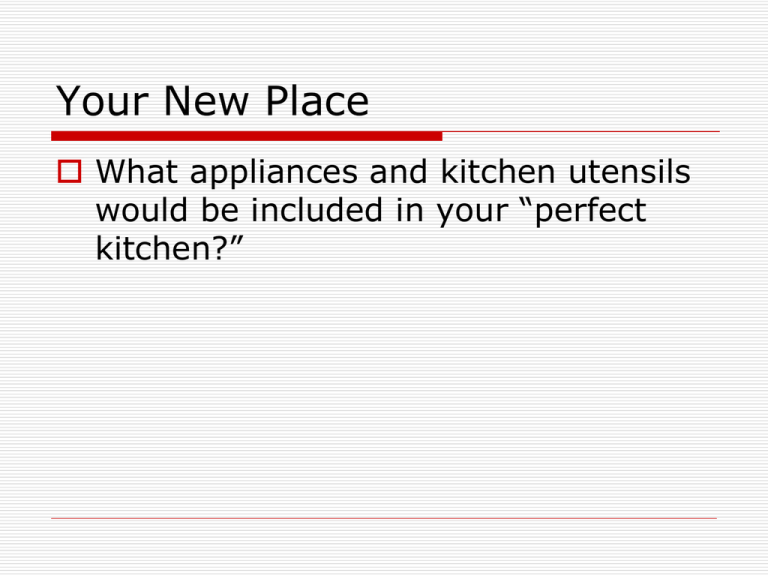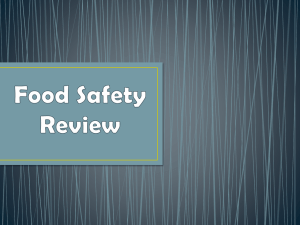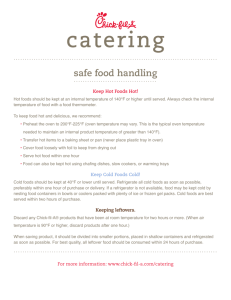Types of Kitchen Equipment
advertisement

Your New Place What appliances and kitchen utensils would be included in your “perfect kitchen?” Types of Kitchen Equipment •3 basic kinds of equipment •Major appliances •Small appliances •Utensils Major appliance A large device that gets its energy from electricity or gas 2 major appliances Refrigerator-freezer for cold storage Range – for cooking Other major appliances include a microwave and dishwasher Small Appliance Small electrical household device used to perform simple task. Mixer Food processor Blender Toaster Utensils Kitchen tools Cups Knives Peelers Pots Pans Other cookware Kitchen Work Centers Designed for a specific kitchen task Includes equipment needed for task, storage space, and safe work area Basic Work Centers Cold Storage Centerrefrigerator/freezer is the focus Plastic storage bags, food wraps, containers for left over food might be nearby Sink Center-main source of water Used for washing fruits and vegetables, draining foods, washing dishes Dishpans and other cleaning supplies should be kept close Basic Work Centers Cooking center-includes the range and cooking tools, pots and pans, potholders Microwave could be part of cooking center but might be near the refrigerator for quick heating of leftovers Other work centers Some kitchens contain separate work centers Mixing center-preparing and mixing foods Measuring cups, bowls, mixing spoons, electric mixer stored here Planning center-space to store cookbooks, recipes, and coupons Why is it important to organize kitchens around work centers? Kitchen Safety General Safety Guidelines Don’t let hair, jewelry, sleeves, or apron strings dangle. They can catch on fire or become tangled in appliances. Keep your mind on what you’re doing. Prevent clutter. Put items back where they belong as you finish with them or after you’ve washed them. General Safety Guidelines Close drawers and doors completely after you open them. You could be seriously hurt if you bump into an open door or drawer. Use the right tool for the job. Don’t use a knife to pry off a jar cover, for example. Take the time to find the tool you need. Store heavy or bulky items, such as cookware, on low shelves so you can reach them easily. Preventing Falls Wipe up spills immediately Eliminate slippery rugs Replace damaged flooring Don’t wear untied shoes, floppy slippers, or long clothing Preventing Cuts Keep knives sharp and use properly Use a drawer divider or knife block Don’t try to catch a falling knife Don’t soak knives in a sink or dishpan Sweep up broken glass immediately Using Electricity Safely Read the owner’s manual Don’t use an electric appliance when your hands are wet or standing on a wet floor Avoid damage to electrical cords Use outlets properly Use care with any plugged-in appliance Watch for problems Hazardous Chemicals Don’t transfer from one container to another Never mix chemical products together Spray products-point nozzle where chemical is supposed to go Store away from food Preventing Range and Microwave Accidents Use potholders and oven mitts Lift up far edge of the cover on the pot when uncovering it Use only those in good condition Keep handles turned to the back or middle of range Keep flammable items away Don’t use plastic near the range Continued Arrange oven racks before you start the oven Stand on the side when opening the oven door Don’t reach into a hot oven Clean up spills and crumbs after oven is cool Turn off when not in use Keep a fire extinguisher handy Children Never leave them alone Use safety latches on cabinets Model safe work habits Proper Handwashing Technique Use water as warm as you can Lather well using soap Rub hands together paying attention to areas between fingers and around nails Scrub at least up to your wrist Rinse well under running water Dry thoroughly with clean towel Keeping Food Safe to Eat Food Safety-following practices that help prevent foodborne illness and keep food safe to eat Approximately 80 million American suffer from foodborne illness, also known as food poisoning. Most cases of food borne illness can be traced to harmful microorganisms-tiny living creatures visible only through a microscope Harmful microorganisms Most harmful microorganisms associated with foodborne illness are bacteria, which are carried by people, animals, insects, and objects. Sometimes an illness is not caused by the bacteria, but the poisons they produce known as toxins. Bacteria will reproduce quickly in the presence of food, warmth, and moisture. Cleanliness in the Kitchen Personal Hygiene Wear clean clothes and cover them with an apron. Spots and stains can hold bacteria. Remove jewelry, roll up long sleeves, ties back long hair. Wash your hands for 30 seconds with warm soapy water. Wear gloves if you have an open wound on your hand. Continued Wash hands immediately after using the bathroom or blowing your nose. Do not sneeze or cough into food. Do not touch your face, hair, or any other part of your body while working with food Work Methods for Food Safety Be sure work areas and equipment are clean before you start preparing food Avoid cross-contamination-letting microorganisms from one food get into another Avoid using cutting boards made of soft wood, they can be a breeding ground for harmful bacteria Continued Wash the top of a can before opening it to keep dirt from getting in the food Wash a spoon after each use if using it for tasting to avoid the spreading of harmful bacteria Keep pets out of the kitchen Keep two towels handy in the kitchen, one for wiping hands, the other for drying dishes Use a clean dishcloth each day. Allow sponges to air dry before reuse. Proper Food Temperature How Temperature Affects Microorganisms Temperature is one of the most important factors in food safety Keeping food at proper temperatures can be critical to preventing foodborne illness Bacteria multiply rapidly at temperatures between 60 and 140 degrees Fahrenheit This range does include room temperatures Bacteria that thrive in these temperatures cause most foodborne illness Continued High food temperatures kill most harmful bacteria Some bacteria produce spores: Cells that will develop into bacteria if conditions are right Freezing food stops the growth of bacteria, but if bacteria or spores were already present, freezing will not kill them Food Handling Guidelines Cook food to proper internal temperature or until thoroughly cooked Taste foods containing ingredients from animal sources only after they are completely cooked Ensure even, thorough cooking when microwaving Don’t leave food out more than 2 hours at room temperature, or more than 1 hour if the temperature is above 90˚F Continued Keep extra quantities of food either hot on the stove or in another cooking appliance, or cold in the refrigerator Do not add more food to a serving dish of food that has been out for a while Discard foods that have been held at room temperature for more than 2 hours Refrigerate food in shallow containers Bring reheated food to an internal temperature of 165˚F or higher to kill any bacteria Thawing Food Safely Place food in the refrigerator where it will thaw slowly For faster thawing, put the package in a watertight plastic bag and submerge in into cold water Change water every 30 minutes Use the microwave for quick, safe defrosting. Foods thawed this way should be cooked immediately Storing Food When food is not properly stored it begins to lose quality and nutrients. Some types of spoilage can cause foodborne illness. Under the right conditions, harmful bacteria, yeasts, and molds can spoil food. What causes food spoilage? Heat speeds up chemical reactions that cause spoilage. Air: Exposure to oxygen can destroy some nutrients such as vitamin C and E. Too little moisture can cause fresh foods to dry out, wilt, or lose nutrients. Too much moisture can provide a breeding ground for bacteria and molds. Continued Light can destroy nutrients, especially vitamin C and riboflavin. Dirt contains harmful microorganisms. Damage to food or packaging: Bulging cans, liquids that spurt when you open the container, or liquids that are cloudy when they should be clear. Basic Storage Principles Every food has a shelf life-the length of time it can be stored and still retain it’s quality Shelf life depends on the type of food, packaging, and storage temperature, and how it is handled. How to Avoid Loss of Quality in Stored Food Buy only what you need Follow rule of “first in, first out” Look for “sell by” or “use by” dates Clean storage areas regularly. Throw out food that has started to spoil or containers have been damaged. Room Temperature Storage Canned, bottled, and packaged foods are shelf-stable-can last for weeks or months at room temperature Shelf-stable foods should be kept between 32˚F and 85˚F Some foods need to be refrigerated after opening Cold Storage Foods that are refrigerated in the store such as dairy, eggs, deli foods, fresh meat, poultry, fish Most fresh fruits and vegetables Onions, potatoes, and sweet potatoes should be in a cool, dry area Some whole grain products, nuts, and seeds. They contain oils that can spoil and give foods an off flavor. Continued Leftover cooked foods Baked goods with fruit or cream filling Any other foods that indicate refrigerate after opening Refrigeration Guidelines Don’t overload Keep foods tightly covered Store meat, poultry, and seafood in the store wrap and in a plastic bag to prevent leaks Wash fruits and vegetables only if removing dirt. Wipe hard-skinned fruits dry and drain others well Continued Label leftovers with the date Don’t let the temperature of the refrigerator fall where frost or ice forms Freezer Storage Keep foods at 0˚F from one month to one year Fresh meats, poultry, fish, breads, and leftovers can be frozen Foods that do not freeze well are cheese, products made with mayonnaise, whole raw eggs, and fresh vegetables that are meant to eat raw Packaging and Freezing Foods Freezer burn-a condition that results when food is improperly packaged or stored in the freezer too long When wrapping solid foods, squeeze out as much air as possible For best quality, freeze food quickly Keep an inventory of food products, date frozen, and quantity Discard any food that thawed or was held above 40˚F for more than 2 hours Keeping Refrigerated Foods Safe Discard fresh meats, poultry, fish, lunch meats, eggs, milk, and cooked foods if they have been held above 40˚F for more than 2 hours Keep butter or margarine if it has not melted and does not smell Fresh fruits and vegetables are safe if they show no signs of mold or sliminess and do not smell





